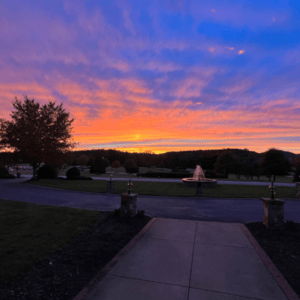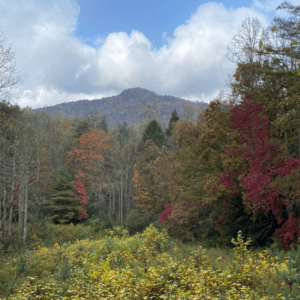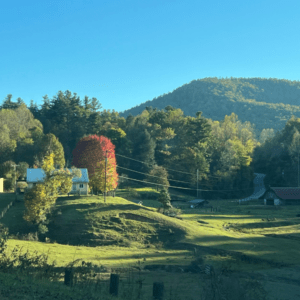On Sunsets, Autumn Leaves, and Arguments for the Metaphysical
Posted on: November 23, 2021
Lisa and I moved to the Upstate of South Carolina from South Florida. We lived near the beach in Jupiter, and many nights after supper, we would make the short drive to the water to watch the sunset over the Intracoastal Waterway or watch the light dim over the Atlantic. The silvers, blues, and lavenders were intoxicating, along with the salt air. When we moved to the Upstate, we thought we would miss those sunsets (we do!) but we were unprepared  for the mountain sunsets here in Tigerville. Our campus’s lovely president’s home faces directly west, and we have an expanse of field between us and the distant tree line so the view is expansive. We have learned to watch for a certain light through our windows, which tells us to hurry to the porch for the vivid display of pinks, grays, and oranges that fills the sky. The sweet mountain air likewise is invigorating, even in the depths of the summer months.
for the mountain sunsets here in Tigerville. Our campus’s lovely president’s home faces directly west, and we have an expanse of field between us and the distant tree line so the view is expansive. We have learned to watch for a certain light through our windows, which tells us to hurry to the porch for the vivid display of pinks, grays, and oranges that fills the sky. The sweet mountain air likewise is invigorating, even in the depths of the summer months.
We also rediscovered fall leaves. Behind North Greenville University is the “blue wall,” an escarpment that rises to the Blue Ridge Mountains that line every bit of the horizon west of campus. In a few minutes, we can be on the first ridges, which open up to the gorgeous valleys, orchards, and river flats that are cradled among the peaks. In late October and early November, the hillsides are ablaze in oranges, reds, and yellows.

The advent of cameras on cell phones and the rise of social media platforms mean that my feeds fill with shots of these vistas during this season. I am not immune to this impulse either. On this post I have affixed two shots: a sunset from our porch from a couple of weeks ago and a shot of a farm near a place where we hike regularly, in Zirconia NC, just over the border from Tigerville.
Social media generally appeals to our basest instincts and the companies know how to manipulate these appeals for profit and adrenaline. Politics, news stories, opinions, misrepresentations, and so much more appeal to our innate desire for conflict and drama, which mire us in the physical. They exhaust us. In the worst cases, they demoralize and discourage us. And too often we are divided by them.
Ah, but then there are sunsets and autumn leaves. They appeal to our higher nature. We are uplifted by them. We are rejuvenated. We are encouraged. And when we share these photos and experiences, we are unified by the shared experience of beauty.
One of my favorite people is Lee Benson, an art professor and thinker with whom I taught at Union University in TN. Lee and I also attended the same church, and sometimes he would provide the offertory prayer on Sunday mornings. His prayers were often an apologetic for art, with his artist’s heart overflowing with gratitude to the God who made the universe a beautiful place. He would note that God didn’t have to make the world so beautiful, but He did. He would say that it’s like our loving God gives us a free art museum filled with wondrous beauty that’s there for us, and all we have to do is stop long enough to see it.
An atheist once confided to me that he thought Christians were stupid in how we often develop arguments for God. He said we constantly started with the rational and logical rather than the emotional; this sets us up for false dichotomies and endless disputations. He said that if we had any sense, we would start with aesthetics, the reality of beauty. He said it was beauty that gave him the most pause in his belief system because he often would visit art galleries and find himself weeping without cause. “Why do I weep at beauty? I have no answer for that in logic, science, or the survival instinct. And yet, I find myself strangely nourished by those spaces.”
Beauty makes no sense from a practical point of view. It’s a uniquely human thing, an emotional response unparalleled in our experience. I have never seen a group of dogs sitting on a ridge at sunset watching the colors change. I never saw one of our cats pause to look at the leaves on an autumnal maple. I’ve never seen a horse pulling a coach stop to behold a cloud formation. And I’ve never seen any of those fellow creatures whip out a phone to take a photo, buy a print to decorate a home, or burst into tears at the sight of overwhelming beauty.
Psalm 19 lays out this argument: the beauty of the created world points out the intentionality of the One who made all things and our unique relationship with Him. It’s one thing for the universe to work—to function in certain ways that are efficient. It’s another for it to be beautiful while it does it. Beauty serves no discernible physical function. Physical attractiveness (however defined) may influence the selection of a mate. The cuteness factor of a juvenile animal may protect it from wanton harm. But the colors of leaves have no discernable function. The streaks in the sky at sunset have no purpose. And the reaction—the singularly human reaction we have to them—is without practical value. But it is something that should make us think, while we think.
Ponder, then, these words:
The heavens declare the glory of God, and the expanse proclaims the work of His hands.
Day after day they pour out speech; night after night they communicate knowledge.
There is no speech; there are no words; their voice is not heard.
Their message has gone out to the whole earth, and their words to the ends of the world.
In the heavens He has pitched a tent for the sun. (Ps. 19:1-4, CSB)




